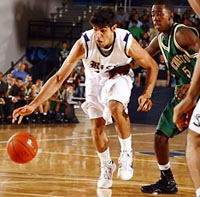|
CONTENTS
1956 NBA Finals
First Iranian
135-point Victory in High School
"As Good an All-Around Guard As I've Seen"
Over a Half-Century of Futility
Who Won the Game?
1946 Rules Changes
First Slam Dunk Contest
Bobby, Larry, and Magic - I
Bobby, Larry, and Magic - II
Superstition Stories: Roy Williams
Basketball Did You Know? – I
Basketball Did You Know? – II
Basketball Did You Know? – III
Basketball Did You Know? – V
Basketball
Magazine
Golden Rankings Home
Back to Top
|
Basketball:
Did You Know? – IV

George Yardley
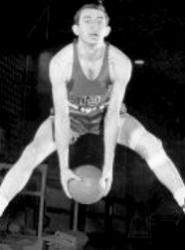
Andy Phillip
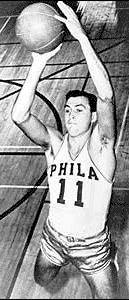
Paul Arizin

Tom Gola
|
For its 1956 Finals, the NBA decided to alternate home games throughout the best-of-seven series.
- After the St. Louis Hawks defeated the Minneapolis Lakers two-out-of-three in the first round, the Fort Wayne Pistons beat the Hawks three-games-to-two in the Western Conference Finals.
- Meanwhile, in the East, the Syracuse Nationals beat the Boston Celtics two-out-of-three. Then the Philadelphia Warriors eliminated Syracuse three-games-to-two.
So the two teams that won their divisions in the regular season met in the finals.
- Charley Eckman's Pistons were led by 6' 5" F George Yardley (Stanford), who averaged 17.4. 6'9" Larry Foust (LaSalle) manned the middle with 16.2 ppg. 6'6" Mel Hutchins (BYU) manned the other F spot and scored at a 12.0 clip. 6'2" Andy Phillip (Illinois) led the squad in assists (5.9); 6'4" Chuck Noble (Louisville) completed the backcourt. Yardley eventually made the Basketball Hall of Fame.
- Warriors' George Senesky, in his first full season as an NBA coach, put this lineup on the court: 6'4" F Paul Arizin (Villanova) led with 24.2 ppg; 6'8" C Neil Johnston (Ohio State) threw in 22.6 ppg; 6'7" F-C Joe Graboski (no college) contributed 14.4; the guards were a pair of LaSalle grads: 6'2" Jack George (13.9) and 6'7" rookie Tom Gola (10.8). Arizin, Johnston, and Gola were future Hall-of-Famers.
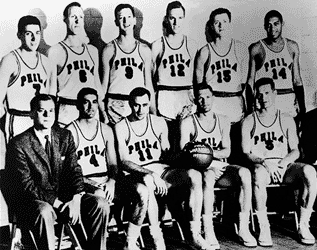 Philadelphia Warriors 1956 Philadelphia Warriors 1956
Since the Warriors had the better regular season record, the Finals began at the Philadelphia Civic Arena on Saturday, March 31.
- With his team down 15 midway through Q2, Senesky inserted second-year F-G Ernie Beck. Despite averaging only 5.2 ppg in the regular season, he sparked the home team with 23 points as Philly pulled out a 98-94 victory before 4,128. Arizin, "the jump shot sensation," led with 28 for the victors to top Yardley by one.
- The teams left immediately for Fort Wayne where Game Two was played at War Memorial Coliseum the very next night. Yardley's two FT with 48 seconds proved to be the difference in the Pistons' 84-83 triumph. 6'5" rookie Corky Devlin then intercepted a Warrior pass with 28 seconds. After Devlin missed a shot, Yardley blocked Arizin's desperation shot to complete the victory.
- Back in Philly two nights later, the teams played another nail-biter. The Warriors prevailed 100-96, thanks in part to Fort Wayne missing 15 of 47 FT. Arizin again led with 27.
- On April 5, the Warriors won in War Memorial Coliseum for the first time since February 1952. Arizin pumped in 28 again to lead Philly to come from behind and take a 106-100 lead with 1:53 left. But the Pistons scored five in a row to trail by one with 40 seconds remaining. George Dempsey hit a FT for the visitors before Devlin swished a shot that did not count because it came a split-second after the buzzer.
- 11,194 braved rain and snow to pack Convention Hall to watch Philly close out the series with a relatively easy 99-88 triumph. Graboski broke out of a slump to add 20 to Arizin's 26. Gola paced a Q3 surge that took the home boys from a one-point halftime deficit to a 9-point bulge at the end of Q3. Tom scored 10 and assisted on three FG in the period.
Philly won its first league title since 1947 while Fort Wayne lost in the finals for the second straight year. The NBA has never returned to the alternate home games format again.
|
The first Iranian to play Division I men's basketball is Rice freshman Arsalan Kazemi.
- When the 6'7" 205 lb F entered the Owls' home opener against Sacramento State, there was no acknowledgement of the unprecedented event either on the scoreboard or over the P.A.
- A handful of Kazem's countrymen were in the crowd of 1,631. One had walked up to him in the pregame layup line to wish him luck. "The reason we are here is to support you."
- "Arsalan" is a Turkish name meaning "lion." Some say that Kazemi often seems sleepy on the floor with a blank expression. But suddenly he roars to life for a rebound or dunk.
- As this is written, Kazemi has played 25 games for Rice. He is second on the team with 10.6 ppg and leads the team with 9.0 rpg. He is second with 33 steals.
Kazemi had been preparing for a basketball career for many years in his native Iran.
- He was captain of Iran's team at the FIBA Under-19 World Championships in Auckland, New Zealand in July 2009. He was one of only two players in the tournament to average a double-double (16.6 points and 12.2 rebounds). He ranked eighth in scoring and second in rebounding. He was the tournament leader in steals, averaging four per game, including seven steals against Team USA – a tournament high.
- He also captained the Iranian Under-17 national team that won the 2007 West Asian championship. He was named the tournament MVP.
- Arsalan played the 2008-9 season at The Patterson School in NC.
|
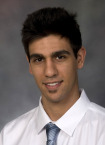
Arsalan Kazemi
|
|
|
135-point Victory in High School
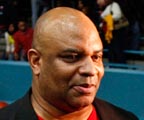
Coach Greg Wise
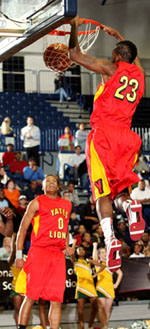
Yates High in action
|
Depending on your viewpoint, Greg Wise of Houston's Yates High School is either the best or the worst basketball coach in the country.
- On January 5, 2010, Wise's team defeated Lee High School 170-35. Up 100-12 at the half, Wise's team pressed full-court to the final whistle. The 170 points broke the Texas state record of Hardin-Jefferson High School in 1992 by four. The 100 points in the first half is also a state record and considered the second most ever scored in a game anywhere. The national single-game scoring record is 211 set by De Quincy (LA) Grand Avenue in 1964.
- It was the eighth time in the young season that Yates scored over 100 and the sixth time the Lions won by more than 60. The victory was the school's 39th in a row.
- The game was marred by a second half fight and questions of sportsmanship. A fracas broke out when a Lee player committed an intentional foul in Q3. After breaking up the fight, the referees told both coaches they would have to play just five players the remainder of the game. The other players spent the rest of the second half in the stands.
- Lee coach Jacques Armant said: "I don't understand why Yates just kept scoring and pressing when they were up so much. These are kids. It isn't good to do that to other young men."
- In defending his coaching philosophy, Yates pointed to the team's only loss in the 2008-9 season when they went 34-1 to win the Class 4A state championship. The one loss was a 78-76 decision to Elsik High of Houston. That night, Wise said he let his kids down by telling them to put on the brakes. "We practice running, pressing, trapping every day," he said. "If we get to a game and I tell them not to do what we do in practice, I am not coaching well. ... We have 15 guys, and all 15 play." Wise said he shouldn't have to tell his "third line" they can't go out and score. "They work really hard in practice, and when they go in, they deserve the chance to play hard and compete, too. ... We aren't scoring on other teams out of disrespect."
How did Yates do the rest of the season?
- Yates was involved in more violence when it defeated Booker T. Washington 132-68. There was fighting, and shots were fired in the parking lot afterward, although no one was hurt.
- Yates won its first two state playoff games by scores of 126-61 and 104-48. Their quarterfinal victory set another national record of 15 consecutive games in which they topped the century mark. The streak ended in the state finals.
- Trailing Lancaster by one point midway through Q4, the Lions' full-court press sparked a 21-1 run that produced a 92-73 victory in front of a record 16,755 fans at Texas's Erwin Center.
- Finishing with a 34-0 record, Yates earned a #1 ranking by USA Today.
|
|
"As Good an All-Around Guard As I've Seen"
Those are the words of William & Mary coach Tony Shaver about Harvard's Jeremy Lin, a 6'3 200 lb senior.
- Since fewer than 0.5% of men's Division I basketball players are Asian American, Lin attracted considerable atatention in the Asian community here and abroad. As many as four TV networks from Taiwan, where Lin's parents were born, covered some of his games.
- As a senior at Palo Alto HS, Jeremy led his team to the Northern California Division II championship. He was named Player of the Year in that division as well as Northern California scholar athlete of the year and first team All-State.
- His freshman year in Cambridge, he was first off the bench, playing in all 28 Crimson games.
- He won the team's MVP award as a sophomore and made second team All-Ivy League.
- Junior year he moved up to first team All-Ivy. He was the only player nationally to rank in the top ten of his conference in every statistical category.
- This past season, he was one of 11 finalists for the Bob Cousy Award as the nation's top PG. His "well-round game – he throws deft passes, is a tough defender" – earned him a nomination for the Wooden Award as the best college player.
When Harvard started 14-3, it was hoped that the Crimson might qualify for the NCAA tournament for the first time in 64 years. Alas, it was not to be, as they lost 4 of their last 11. Instead of making either the NCAA or NIT tournaments, they were invited to the CIT (Collegeinsider.com) tournament, where they lost in the first round to Appalachian State.
Jeremy finished his senior season with these stats for Coach Tommy Amacker.
16.4 ppg, 51.9 FG%, 4.5 assists-per-game
Lin has signed with an agent and hopes to play in the NBA. Although some call him the "Asian Steve Nash" and it would be an inspirational story, especially if he were to play for Golden State in his home area, scouts generally don't think he will be drafted. However, he will probably sign with a team as an undrafted free agent.
|
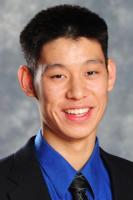
Jeremy Lin

Jeremy Lin in action
|
Reference: "Postcard: Cambridge," Time, January 25, 2010
|
Over a Half-Century of Futility
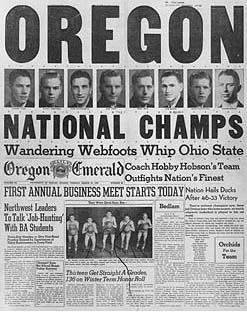
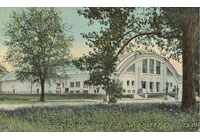
Old Patten Gym at Northwestern
|
The first NCAA basketball tournament was played in 1939. Eight teams competed in a single-elimination format.
- The East regional was played at Philadelphia. In the quarterfinals, Villanova defeated Brown 42-30, and Ohio State got the better of Wake Forest 64-52. Then the Buckeyes upended the Wildcats 53-36 to advance to the finals.
- In San Francisco, Oregon outran Texas 56-41, and Oklahoma defeated Utah State 50-39. Then Oregon trounced the Sooners 55-37.
- Ohio State met Oregon in Patten Gym at Northwestern University in Evanston IL. The Ducks outpointed OSU 46-33 to capture what is still the school's only NCAA crown.
- Northwestern also hosted the Final Four in 1956, when San Francisco, led by Bill Russell, defeated Iowa 83-71 for the championship.
The irony of this story is that, 71 years after hosting the first final, Northwestern has never been invited to the NCAA tournament.
- The only private school in the Big Ten has produced 20 Pulitzer Prize winners, five Academy Award recipients, four Nobel Prize laureates, and a Supreme Court justice.
- Since 1939, over 300 teams have made the tournament, including all the other schools in the six major (BCS) conferences. Indiana has made it 35 times. Even Tufts made it (1945), and the Jumbos are now in Division III.
- The NU Wildcats have been to NIT twice in the last 10 years but lost both times in the first round. A point shaving scandal in '98 hurt the program badly. The school also suffered from the murder of former coach Ricky Byrdsong by a white supremacist in '99 and a 0-16 conference record in 2000.
- As the 2009-10 season progressed, hope was raised that the Wildcats might finally join the Big Dance. Going into conference play, NU was 11-1. But they went only 7-11 in the Big Ten. They did defeat Indiana in the first round of the Conference tournament but lost to Purdue in the next game. So, once again, the Wildcats went to the NIT where they lost in the opening round, this time to Rhode Island 76-64. That made the school's post-season record 2-4.
|
|
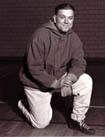
Dutch Lonborg
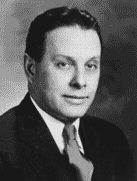
George Keogan
|
Associated Press article about a basketball game played on December 31, 1935.
Not all of today's headaches in the neighborhood were traceable to New Year's eve celebrations. Part of them were due to last night's basket ball battle between Notre Dame and Northwestern. According to the official scorebook, Northwestern had squared its home-and-home series with the Irish, with a 20-to-19 victory at Evanston. However, there was other evidence that the result was a 20-to-20 tie. The official scorers, Bill Gillesple and John Glenn, student managers of basket ball for Notre Dame and Northwestern, respectively, agreed that the score was 20 to 19. Sports writers covering the game, however, were just as sure the score was 20 to 20. The official version, which, according to the rules must be accepted, credited Ray Meyer, Notre Dame forward, with only one successful foul shot attempt. The writers had him in their books for two. Neither of the undergraduate scorers was certain a free throw by Meyer hadn't been lost somewhere. Great confusion followed the finish of the game. Both teams and their coaches left the floor, while scorers and officials conferred. The crowd, already highly excited over a tough battle, remained expecting to see an overtime period. Coach Arthur ("Dutch") Lonborg of Northwestern said the official scorebook was final as far as he was concerned. George Keogan, Notre Dame's coach, made no protest. Notre Dame led at the half, 12 to 6, but was outplayed by a decisive margin in the closing period.
Ray Meyer went on to become a Hall of Fame basketball coach at DePaul.
|
 Ray Meyer
Ray Meyer |
|
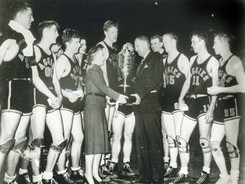
Oklahoma State 1946 NCAA Champions
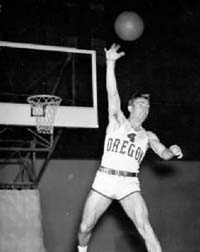
1940s Backboard
|
March 27, 1946 Associated Press report
Drop 4-Minute Cage Rule
NEW YORK — The basketball rule prohibiting re-entry of any player in the last four minutes of a game—a coach's headache during its one season in the book —went out of the window today and a more liberalized version was ready to take its place. The modification of the four minute rule was one of four minor changes made in the cage sport's legislation by the national basketball committee of the United States and Canada which closed its annual two-day rules-making session here Tuesday.
Under the new rules, one reentry per player will be allowed during the last four minutes of a game and the clock will be stopped automatically throughout that period whenever the ball is dead. The committee also decided to:
1. Make the use of transparent backboards optional and submit recommendations for markings on such backboards at a later date.
2. Make it mandatory to call a "jump ball" six feet in from the boundary whenever the ball goes out after having been touched by two opposing players simultaneously, or if the officials can't agree who touched it last, or if their vision was blocked and they don't know who touched it last.
3. Amend the running rule so that a player who comes to a legal stop with his feet parallel can use cither foot as his pivot foot.
|
|
The first Slam Dunk Contest was conducted not by the NBA but by the ABA.
- The 1976 American Basketball Association All-Star game was scheduled for January 27 at McNichols Arena in Denver.
- The league was struggling for survival. The new Baltimore franchise had folded before the end of training camp. Utah and San Diego went down early in the season. Only seven teams remained in one division.
- It was decided to pit the league-leading team against all-stars from the other six squads. Luckily, the host Nuggets occupied the top spot, which would increase attendance.
- Carl Scheer, Nuggets GM, Jim Keeler of the ABA office, and Jim Bukata, the league PR man, arranged a pregame show featuring Glen Campbell and Charlie Rich. But they wanted "a very strong gimmick for halftime" (Bukata's words) for the game which would be televised in a number of ABA cities.
- Bukata recalls the planning meeting: "I said, 'Hey, let's have a Slam Dunk Contest.' Everybody said, 'Great.' Then we all said, 'Okay, how do you have a Slam Dunk Contest?'"
It was fitting that the ABA stage the first Slam Dunk Contest.
- Dan Issel, star C for the host Nuggets: "The Slam Dunk Contest went right to the heart of the old ABA. The dunk was a bigger play in the ABA than it is in today's NBA; it was a statement of your manhood and your talent. The dunk was so important to the ABA that the pregame warm-ups became a show. The Nets had a guy named Ollie Taylor who would just go off in pregame. He would windmill, do reverse dunks, everything you could think of, and the fans would get pumped up before the game even began. The contest was an invevitable extension of that."
- The ABA also featured the three-point basket and the red, white, and blue ball.
Still, the format and rules had to be created from scratch.
- To save money, the planning committee invited five players who would be in Denver for the game.
- 6'6" Julius Erving, New York Nets
- 6'7" George Gervin, San Antonio Spurs
- 7'2" Artis Gilmore, Kentucky Colonels
- 6'9" Larry Kenon, San Antonio Spurs
- 6'4" David Thompson, Denver Nuggets
- The committee figured the contest would be between Erving, even then known as "Doctor J," and the rookie Thompson, the local favorite.
Julius had trepidations about the contest.
- "When the idea of a Slam Dunk Contest was presented, it concerned me some, because I had never been in one before. I always considered myself a very good dunker, and I wanted to win, but my best dunks were always done in the game. I didn't think about them, I just did them."
- "The other thing about the contest was that it would be held at halftime, so we would all have been playing and our legs would be a little tired."
- "None of us did much preparing for the contest; we all sort of winged it."
Before the game, Doug Moe, a former ABA player with the New Orleans Bucs and an assistant to his buddy Larry Brown with the Nuggets that year, discussed with fellow New Yorker Doctor J the latter's plan to take off from the foul line and slam it.
- "In his usual obnoxious way," Moe said that nobody, J included, could dunk taking off 15' from the basket.
- Many players said the Doctor could, leading to many side bets.
When halftime came, the players didn't go to the dressing rooms but sat on the floor along the sideline to watch the show.
- "When a guy would make a good dunk, you'd see the other players cheering, giving each other high fives. It was like we all were back on the playground watching this shootout." (Issel)
- Bukata: "Probably the most spectacular dunk of the night didn't even count. In the practice session, Thompson did this cradle dunk where he cradled the ball in his left arm and then leaped over the rim and punched the ball down through his arm into the rim. He really was dunking the ball with his fist."
- Erving had developed a plan for his mandatory dunks.
- First dunk (standstill): "I took a basketball in each hand and then slammed one after the other."
- Second dunk (left side): "Iron Cross: I'd jump by the basket, spread out my arms as if I were flyling and then dunk the ball behind me without ever looking at the rim."
- Third dunk (right side): "I drove under the basket, grabbed the rim with my right arm and slammed the ball with my left."
- Scheer: "The fans were going crazy all during the contest, as if they were seeing something they'd want to tell their grandchildren about. And for the people watching on the court, the tension was building because we were all waiting for Julius's long dunk."
When Julius prepared for his long dunk, Moe went to the sideline even with the foul line to make sure Erving didn't step on over over the foul line.
- Erving: "I had dunked in practice from behind the foul line, so I knew I could do it. But I had to get my stride just right. Everything had to be perfect for it to work."
- J went to the foul line, turned, and trotted off the distance for his run-up. The crowd started screaming until he turned and faced the basket. Then silence as he took off with his antelope-like strides.
- Scheer: "The arena was so quiet you could hear his every step as his shoes touched the floor. ... Then he was off, in the air, and he brought the ball back from behind himself somewhere as if he were a helicopter. He rammed it through the rim, and only when the ball hit the floor did the crowd. People just went crazy."
- Bukata: "If you watch the tape of the dunk, you'll see Doug Moe pointing to the foul line, indicating that Julius's foot was on the line."
- Erving: "I did step on the line, as Doug Moe was quick to point out. I said to Doug, 'Look, I'm not doing that again. No one else can dunk from anywhere near as far out as I just did.' Then we all laughed."
- The makeshift panel of four judges, which include an elderly woman who was a Nuggets fan and a local high school coach, voted Erving the winner.
After that season, the ABA finally got the merger with the NBA that it had long sought. It was not until 1984, however, that the NBA finally held its first Slam Dunk Contest. (See Quiz below.)
Video of Slam Dunk Contest: Part I | Part II
Reference: Loose Balls: The Short, Wild Life of the
American Basketball Association, Terry Pluto |
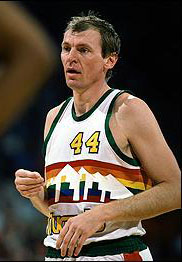
Dan Issel

Julius Erving
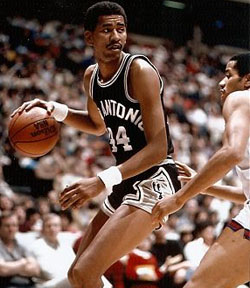
George Gervin

Artis Gilmore

Larry Kenon
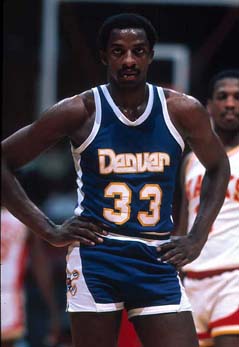
David Thompson
|
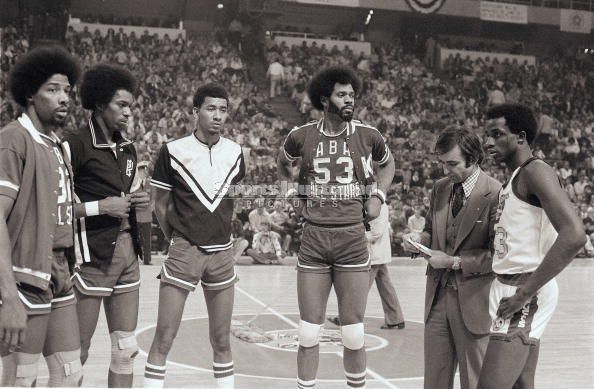
Original Slam Dunk Contest participants (L-R): Julius Erving, Larry Kenon, George Gervin, Artis Gilmore, and David Thompson
Back to Top
Bobby, Larry, and Magic - I
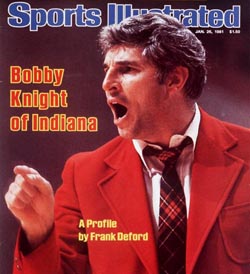
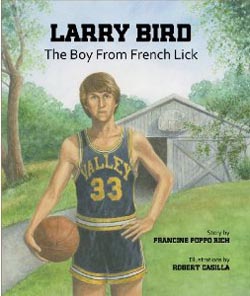
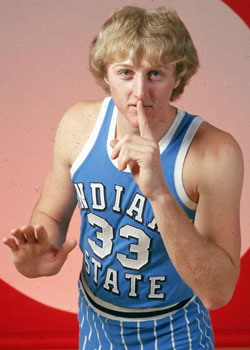

Coach Bill Hodges
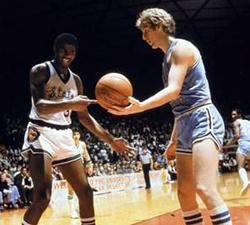
Magic Johnson and Larry Bird in 1979 NCAAFinals
|
Coach Bobby Knight came close to having two of the greatest players in basketball history as teammates on his Indiana squad.
- Larry Bird from the small town of French Lick IN attracted college recruiters in his junior year in high school.
- One of his suitors was Louisville coach Denny Crum. However, Larry refused to visit the school.
- Crum didn't give up, and one afternoon Larry discovered the coach shooting baskets in his high school gym. When Bird again refused the invitation to make a visit, Crum made a proposition.
- "I'll play a game of HORSE with you. If I beat you, you've got to come for a visit." Bird agreed but soon regretted it. The former UCLA G under legendary John Wooden matched Larry basket for basket for 15 minutes until Bird finally prevailed.
The only out-of-state school that peaked Bird's interest was Kentucky.
- Larry visited the beautiful campus in Lexington 135 miles from home.
- The problem was that Wildcat Coach Joe B. Hall considered Bird too slow to get off his shot in the SEC. So Hall quit recruiting him.
- "I don't know if I would have gone there," Bird says. "They ended up taking Rick Robey instead of me. He was 6-foot-11, and they got who they wanted and won a national championship."
That left Indiana, his mother's choice, and Indiana State, his father's preference.
- Hoosier coach Bobby Knight gave Bird the same spiel he gave every other recruit: no shortcuts, no guarantees, no special treatment.
- Since that was what Larry and his mother wanted to hear, he chose IU, 49 miles north of French Lick.
It didn't take Bird long to realize he was a fish out of water in Bloomington.
- He hadn't traveled very far from French Lick, and he quickly realized his wardrobe and other possessions didn't stack up to most of the other students, including his roommate, Jim Wisman, another basketball recruit.
- In the beginning, Bird spent almost every evening at the place where he felt right at home - Assembly Hall, the basketball arena. He and Wisman and other freshmen hoped to get into games with the varsity players but rarely did.
- So the freshmen switched to the outdoor courts. Soon some varsity men began showing up, drawn by tales of the top-notch basketball being played.
- One of the older players was All-American Scott May, who made jumper after jumper over Bird, frustrating and even humiliating the young forward. Larry learned from Scott how to lean into the defender, then lean back slightly to launch his shot.
- Bird bumped into Coach Knight just a few times because official workouts hadn't started yet. Intimidated, Bird said very little to Bobby, not telling him about his unhappiness.
- More and more disenchanted and lacking money to improve his status, Bird stuck it out to please his mother. But that resolve vanished when he broke his toe during a pickup game on an outdoor court. He limped from class to class, often arriving late./li>
- He departed after 24 days to the chagrin of his mother, who dreamed of him being the first member of the family to graduate from college. She didn't speak to her son for a month and a half.
- Larry never heard from Knight. "I have no clue when Coach Knight even realized I was gone. They had a great team. I'm sure he was thinking, 'The hell with Bird.' I can't say I blame him."
Larry moved in with his grandmother and explored other alternatives.
- He enrolled in nearby Northwood Institute but left after two weeks because he was way too good for that level of basketball.
- The town of French Lick hired him to do outdoor tasks like cutting trees, painting street signs, and so on. He continued to play in pickup games, summer leagues, and AAU tournaments.
- Among the many recruiters who contacted him, Bill Hodges, an assistant at Indiana State, showed up unannounced at Bird's home and other places in the town where he might find Larry or his mother.
ISU head coach Bob King's reservations about Larry's ability disappeared one night when he and Hodges attended an AAU game between Bird's team and an Indiana All-Star team.
- Larry hurried to the game directly from a job that involved putting up 1,300 bales of hay that week. Noticing the scratches on Larry's arms, King guessed where they came from. "I bet your arms are pretty tired," the coach said. "I can barely lift them," Bird admitted.
- All he did that evening was score 43 points and hault down 25 rebounds against the all-stars. "We need to get you up to Terre Haute," King told him after the game.
Bird enrolled at ISU in the fall of 1975.
- After sitting out a year as required by the NCAA transfer rules, he played three seasons for the Sycamores.
- His final year, with Hodges as head coach, ISU went undefeated in 33 games before losing to Earvin "Magic" Johnson and Michigan State in the 1979 NCAA Final.
|
Reference: When the Game Was Ours, Larry Bird and Magic Johnson with Jackie MacMullan
Back to Top |
Bobby, Larry, and Magic - II
Indiana coach Bobby Knight tried to recruit an out-of-state player who went on to become one of the greatest ever.
- In 1976, fresh off an undefeated national championship season, Knight traveled to East Lansing MI to visit Earvin Johnson at Everett High School. Johnson still rates that visit as one of the greatest thrills of his life.
- The player who would come to be known as "Magic" woke up an hour early that morning and hurried to the school gym to shoot 100 FTs just in case Coach Knight wanted him to shoot some freebies.
- Knight told George Fox, Johnson's coach, that he would meet with the prospect when school ended. Yet half an hour before the final bell sounded, Fox ran into Knight in the hallway near Magic's classroom. "Coach, you're early," Fox said. "I always am," Bobby replied. "When I recruit a player, I like to see him with his peers, check out his attitude with the other students."
- Knight perceived Johnson to be a confident, outgoing young man revered by his classmates as the undisputed leader of the student body.
Earvin sat in the cafeteria with Knight and Fox.
- Earvin lost his bravado because he was intimidated by Knight. But he extended his hand, and Bobby shook it warmly.
- Knight put his two companions at ease by telling anecdotes illustrating his passion for basketball. Magic recalls, "He had a great smile. I don't think I had ever seen him smile before."
- The Hoosier head man explained that all his players were required to go to class and graduate. "If you come, you will be treated like everyone else. You will be expected to earn your spot. I don't give anybody anything. You have to prove to me you deserve it."
- Johnson found the approach refreshing after many schools promised him corner lockers, starting jobs, as well as clothes, cash, and cars - perks that violated NCAA rules.
- The discussion took a different turn when Knight suddenly asked, "So, Earvin, where the hell are you going to school?" Johnson admitted he wasn't sure. "I don't know about Indiana. If you started getting in my face, I'm not sure how I'd react to that."
- With that, Knight stood up, shook Fox's hand, and left. "That was it," said Magic. "I never spoke to or heard from him again."
- "To tell you the truth, I regret not taking a visit. He was a tremendous coach. And just imagine if Larry had stayed and I had gone there. The two of us would have played in college together. Now that would have been something."
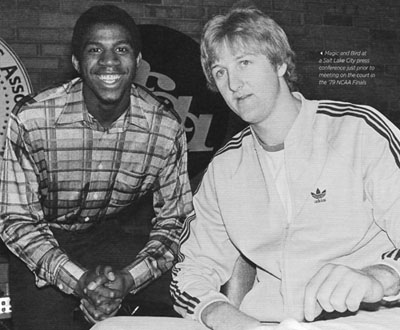
Magic and Larry before NCAA Championship Game Magic signed with his hometown Michigan State Spartans and led them to the 1979 NCAA Championship against Larry Bird's Sycamores of Indiana State. The two then dueled throughout their Hall of Fame careers with the Los Angeles Lakers (Johnson) and Boston Celtics (Bird).

Bird signs with the Celtics. Reference: When the Game Was Ours, Larry Bird and Magic Johnson
with Jackie MacMullan
Back to Top |
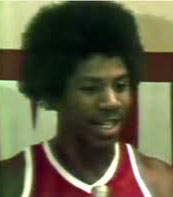
15-year-old Earvin Johnson
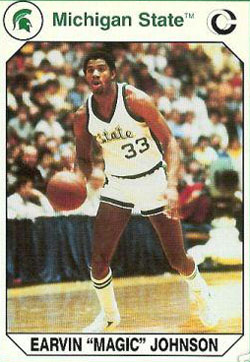
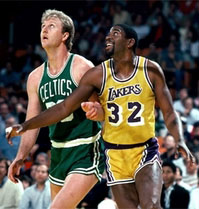
Larry Bird and Magic Johnson
|
Superstition Stories: Roy Williams
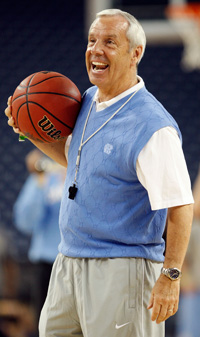
Roy Williams
|
In his autobiography, North Carolina coach Roy Williams confesses to several superstitions.
- During his senior year at Roberson High School in Asheville NC, he played on the baseball team. He forgot his socks for the first game; so he borrowed socks from a teammate. His team lost. The next game, he wore his own socks and won. Forgetting to wash them, he wore them again the next game, another win. So he kept wearing the same pair of unwashed socks as the team won 13 in a row. The streak ended in the state playoffs. "On the ride home I threw the lucky socks out the bus window," writes Roy.
- Fast forward to 1982 when Roy was an assistant to Dean Smith at UNC. The Final Four was held in the Superdome that year.
One of the vendors on Bourbon Street told me I should spit in the Mississippi River for luck. I did it every day we were there and we won the national championship. Now every time I've had a team playing a big game along the Mississippi, I spit in the river.
- He continued to find good luck charms when he became head coach at Kansas.
Before every home game at Kansas I would go for a jog, stop at Phog Allen's gravesite, pat the headstone and say, "Doc, we need all the help we can get tonight." If it was a really big game I'd do that same thing at Dr. Naismith's grave as well. I never get a haircut on the day of a game and if I wear a tie for the first time and we lose, I'll never wear it again.
Reference: Hard Work: A Life on and off the Court, Roy Williams with Tim Crothers
Basketball Did You Know? Archive | Back to Top |
|
|





 Philadelphia Warriors 1956
Philadelphia Warriors 1956
